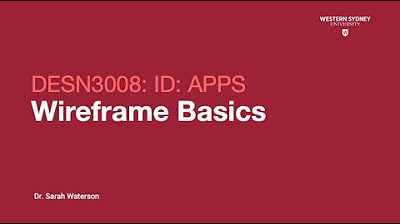20 System Design Concepts Explained in 10 Minutes
Summary
TLDRThis video script offers an insightful guide for developers aiming to scale applications and enhance their system design skills. It covers essential concepts like vertical and horizontal scaling, load balancing, CDNs, caching, IP addressing, TCP/IP protocols, HTTP, REST, GraphQL, gRPC, WebSockets, and databases including SQL and NoSQL. It also delves into replication, sharding, and the CAP theorem, providing a comprehensive overview of building scalable and robust systems.
Takeaways
- 🚀 Vertical scaling involves adding more resources like RAM or upgrading the CPU to scale a server, but it has limitations.
- 🔄 Horizontal scaling adds server replicas to handle more requests, allowing for almost infinite scaling and redundancy but introduces complexity.
- 🔄 Load balancers distribute incoming requests to multiple servers, preventing overload and providing fault tolerance.
- 🌐 Content Delivery Networks (CDNs) serve static files from a network of servers worldwide to reduce latency and improve performance.
- 💾 Caching is a technique to store copies of data for faster retrieval, used at various levels including browser, disk, and CPU cache.
- 🌐 IP addresses uniquely identify network devices, and the Internet Protocol Suite (TCP/IP) defines the rules for data transmission over the internet.
- 🔄 TCP is a reliable protocol that ensures data packets are sent and received in order, and is the foundation for many other protocols like HTTP and WebSockets.
- 🌐 DNS translates domain names to IP addresses, with DNS records like A records mapping domains to server IP addresses for quick access.
- 📚 HTTP is an application-level protocol that simplifies data transmission over TCP, following a client-server model with request and response headers and bodies.
- 🔄 REST is a popular API pattern that standardizes HTTP APIs, making them stateless and following consistent guidelines for responses.
- 📈 GraphQL allows clients to make a single request to fetch exactly the resources they need, reducing over-fetching and the number of requests.
- 🔄 gRPC is an RPC framework that uses Protocol Buffers for efficient binary data serialization, improving performance over REST APIs that use JSON.
- 🔄 WebSockets enable bi-directional communication, allowing for real-time data transfer without the need for polling, as in chat applications.
- 💾 SQL databases organize data into tables and rows, providing efficient storage and retrieval with ACID compliance for reliability.
- 🔄 NoSQL databases drop the consistency requirement of ACID and the relational model, allowing for horizontal scaling and different data models like key-value, document, and graph stores.
- 🔄 Sharding and replication are techniques used in databases to scale horizontally and improve read performance, respectively.
- 🔄 The CAP theorem highlights the trade-offs in distributed systems between consistency, availability, and partition tolerance.
- 🔄 Message queues provide durable storage and can be used for decoupling parts of an application, allowing for asynchronous processing of data.
Q & A
What is the difference between vertical scaling and horizontal scaling?
-Vertical scaling involves adding more resources like RAM or upgrading the CPU of a single server, which is easy but limited. Horizontal scaling, on the other hand, involves adding replicas of the server to handle subsets of requests, allowing for almost infinite scaling and redundancy without requiring high-end machines.
Why is a load balancer necessary in a horizontally scaled system?
-A load balancer is needed to distribute incoming requests evenly across multiple servers, preventing any single server from being overloaded while others are underutilized. It also provides fault tolerance by ensuring that if one server fails, others can continue to handle requests.
What is a Content Delivery Network (CDN) and how does it work?
-A CDN is a network of servers distributed worldwide that serves static files like images, videos, and sometimes HTML, CSS, and JavaScript files. It works by caching copies of files from the origin server onto CDN servers, which can be done on a push or pull basis, reducing latency and improving load times for users.
What is the purpose of caching in computer networks?
-Caching is used to create copies of data so that it can be retrieved faster in the future. It reduces the need for repeated network requests, which can be expensive in terms of time and resources, by storing data at various levels, from browser cache to CPU cache.
How does the Domain Name System (DNS) translate domain names to IP addresses?
-The DNS is a decentralized service that maps domain names to IP addresses using DNS records, such as the A record for address mapping. When a DNS query is made, the system uses these records to retrieve the corresponding IP address, which is then cached by the operating system to avoid repeated queries.
What is the main advantage of using HTTP over TCP for web browsing?
-HTTP is an application-level protocol built on top of TCP that provides a higher level of abstraction, making it easier for developers to work with. It follows the client-server model and includes methods like GET and POST, which simplify the process of sending and receiving data over the internet without worrying about individual data packets.
What are the main differences between REST and GraphQL API patterns?
-REST is a standardization for HTTP APIs that makes them stateless and follows consistent guidelines, using different HTTP status codes to indicate success or error. GraphQL, introduced by Facebook, allows clients to make a single request and specify exactly which resources they need, reducing over-fetching and the number of requests made.
How does gRPC differ from REST in terms of performance?
-gRPC uses protocol buffers, which serialize data into a binary format that is more storage-efficient and faster to send over a network compared to JSON used in REST APIs. This results in a performance boost, especially for server-to-server communication.
What is the purpose of Websockets and how do they differ from HTTP?
-Websockets provide bi-directional communication, allowing for real-time data transfer between a client and server. Unlike HTTP, which requires polling to check for new data, Websockets push updates immediately when new data is available, making them ideal for applications like chat apps.
Why are databases like MySQL and PostgreSQL preferred over storing data in text files?
-Databases offer more efficient data storage using data structures like B-trees and allow for fast retrieval of data through SQL queries. They are also ACID-compliant, ensuring durability, isolation, atomicity, and consistency, which are crucial for maintaining data integrity.
What is the CAP theorem and how does it relate to database design?
-The CAP theorem states that in the presence of a network partition, a database can only guarantee two out of three properties: consistency, availability, and partition tolerance. It helps database designers make trade-offs in replicated systems, often choosing between consistency and availability based on the system's requirements.
What is message queuing and how does it benefit a system with high data intake?
-Message queuing involves using a system like a message queue to persist data before it can be processed, especially when the system receives more data than it can handle. This not only helps in managing data flow but also decouples different parts of an application, improving system architecture and reliability.
Outlines

This section is available to paid users only. Please upgrade to access this part.
Upgrade NowMindmap

This section is available to paid users only. Please upgrade to access this part.
Upgrade NowKeywords

This section is available to paid users only. Please upgrade to access this part.
Upgrade NowHighlights

This section is available to paid users only. Please upgrade to access this part.
Upgrade NowTranscripts

This section is available to paid users only. Please upgrade to access this part.
Upgrade NowBrowse More Related Video

Wireframing basics

The Complete Web Development Roadmap [2024]

Javascript Interview Questions ( Functions ) - Hoisting, Scope, Callback, Arrow Functions etc

Roblox Studio - Building Tutorial | Basics

How To Develop AI Apps 100% For FREE!

BEST Opportunity To Get Placed As A Software Engineer at MAANG? | HeyCoach Review
5.0 / 5 (0 votes)